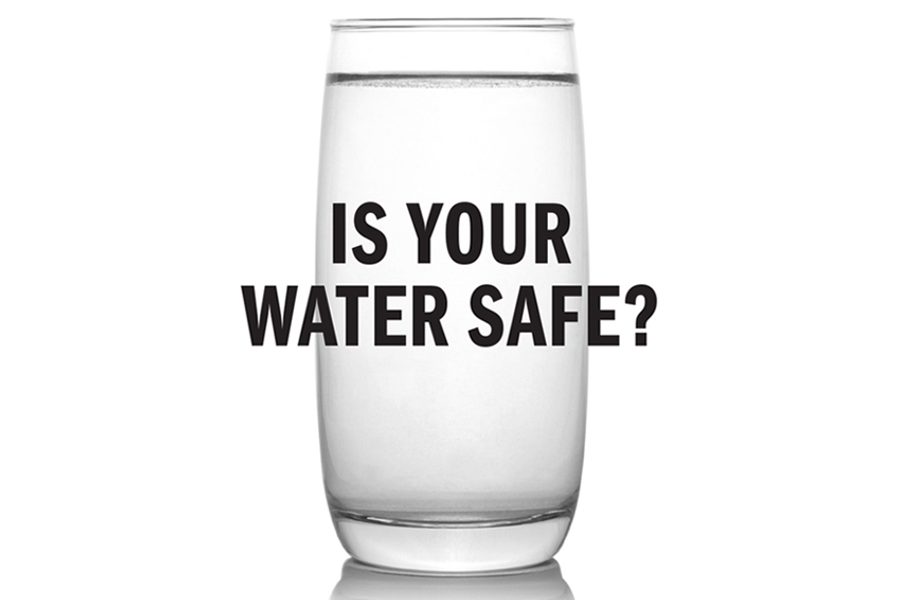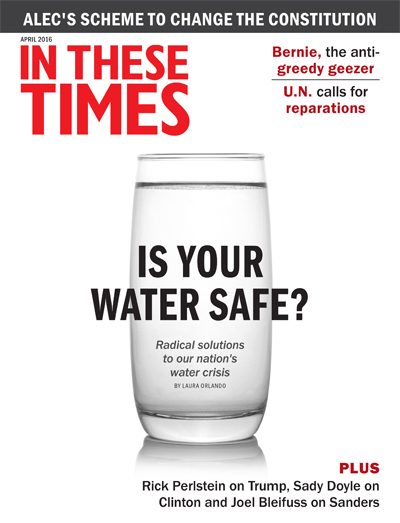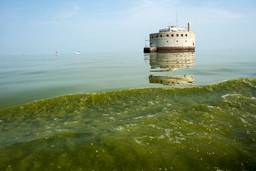Why Your Water Could Be Worse Than Flint’s
Our nation’s water crisis requires radical solutions.
Laura Orlando

Flint residents knew there was a serious problem with their water when it came out of the tap brown and foul-smelling after the city of Flint changed its source from Lake Huron to the Flint River two years ago. They didn’t know, however, that lead levels were so high that the Environmental Protection Agency could classify it as hazardous waste. It took Michigan Republican Gov. Rick Snyder and the Michigan Department of Environmental Quality more than 17 months to acknowledge the problem. As a result, tens of thousands of Flint residents have been — and continue to be — poisoned.
The names of the people who made the decisions behind the poisoning are known. Snyder set the wheels in motion with a scheme that sacrificed the health of the people of Flint on the altar of austerity. In 2011, he ended public oversight by appointing his own man — an “emergency manager” — to cut costs and run the city. Flint went through a series of four emergency managers in as many years. When the extent of poisoning was known, Snyder did nothing. He failed to warn people against drinking the water and he failed to provide a safe alternative.
It’s infuriating. But anger is not action. What can we do to prevent the next municipal drinking water disaster? It is already here, flowing into the water glasses of millions of Americans. Chicago, Philadelphia and hundreds of other cities with old pipes have a lead problem. And that’s just the start of the municipal water pollution crisis. In most of the country, once-clean drinking water sources are now profoundly polluted—by treated and untreated sewage, by chemical-intensive agriculture, by waste from confined animal feeding operations and by industrial discharges. Even in Flint, the story begins not with lead pipes but with failed attempts to “treat” the source of the city water supply: the open sewer that is the Flint River.
Pipes and fixtures can be replaced, but all of the chemical contaminants in our drinking water cannot be removed, no matter how advanced the technology. The solution is to prevent them from getting there in the first place.
Flint: The whole story
Just as there’s no mystery about the toxic combination of racism and neoliberalism that caused the Flint water crisis, there is no mystery about the chemistry that caused the lead to leach from Flint’s pipes. Lead rarely occurs naturally in water. It enters our drinking supply either from industrial or wastewater-treatment discharges or, more commonly, because it leaches out of lead pipes, solders and brass fixtures in the distribution network.
Some conditions make the lead leach faster. This is what happened in Flint when, under the control of an emergency manager, the city switched its water source from Lake Huron to the Flint River and then added chemicals that made the situation worse.
It’s not that the Flint River has elevated levels of lead in it. The trouble — besides the high bacteria levels and untold number of harmful chemicals — is that its water is corrosive. Depending on the rainfall conditions at the time of measurement, as much as half of the river is made up of wastewater from the city’s sewage treatment plant. Before it’s released into the river, the wastewater is treated with chlorine.
Pulling drinking water from a river of treated sewage is not unusual. A 1980 EPA study (the most recent one conducted) indicated that more than 24 major public water utilities got their water from rivers in which sewage treatment plant discharges constituted over 50 percent of the flow during low-flow conditions. In 1985, there were about 6,700 municipal wastewater treatment plants. Since then, an additional 10,000 have been built, which collectively disgorge 33,657 million gallons per day of effluent into rivers, lakes, streams and oceans. To give you an idea of how that compares to public water use, 23,800 million gallons per day are used for drinking water, landscaping, toilets, showers and sinks, and another 18,200 million gallons per day go to industry and commercial businesses.
The Flint sewage treatment plant, located on the banks of the Flint River, keeps 20,000 pounds of chlorine on hand. The wastewater leaving the plant — which averages 32 million gallons per day, but can be as high as 75 million gallons per day — is chlorinated before being dumped into the Flint River.
Disinfecting wastewater with chlorine is a common practice in wastewater treatment that helps the effluent stay below regulatory levels for coliforms— an indicator of fecal contamination. (This does not mean the Flint River is without coliform bacteria. Tests published by the city of Flint show high coliform levels in the river. Sewage treatment overflows, leaks and illegal sewer pipes dumping into the river could be the cause of this.)
Adding chlorine to water is an effective way to dramatically reduce pathogenic bacteria. But chlorine solves one problem only to create another: It helps create the chemical conditions that free up lead from pipes, solders and fixtures. The city could have lessened the corrosion by adding a corrosion inhibitor, such as orthophosphate, to the water — a measure that would have cost just $100 a day — but chose not to.
However, the city had another problem that couldn’t be so easily ignored. Chlorine mixed with water creates a class of chemicals called disinfection byproducts (DBPs). There is epidemiological evidence of a close relationship between DBPs and cancer. The EPA regulates just four of the more than 500 known DBPs, one of which, trihalomethanes (THMs), was already in the Flint River at concentrations in violation of EPA drinking water standards. The city needed to lower bacteria levels in its water, but couldn’t add more chlorine without raising concentrations of THMs, so it switched to chloramine (chlorine plus ammonia), which solves the problem of THMs but leaches lead even faster than chlorine. (Chloramine also creates its own DBPs, but these are not regulated.)
Chloramine’s highly corrosive effects are well-documented. In 2001, after a switch from chlorine to chloramine, tests showed Washington, D.C., water was leaching lead from the distribution system. Civil engineering professor Marc Edwards of Virginia Tech, an expert on water treatment, sounded the alarm. Just like the whistleblowers in Flint, the municipality and the EPA ignored him. It took two years for the D.C. water authority to notify the public about high lead levels in the water. Then the city began partial lead pipe replacement — a solution that has been shown to, counterproductively, “result in significantly elevated levels of lead in tap water … for weeks and months,” as EPA chemist Michael Schock told Environmental Health Perspectives in 2010. (Scientists are still trying to figure out why this happens.)
The D.C. case was widely publicized. But if the city of Flint was to continue using Flint River water, it had to address the immediate problem of the cancer-causing THMs, the chlorine byproducts. So the city made the switch from chlorine to chloramine.
Flint, like all cities in the United States with pipes over 30 years old, has lead in its distribution system. The same story of chloramine corrosion unfolded in Flint as it had in D.C. In summer 2015, Dr. Mona HannaAttisha, a Flint-based pediatrician, got a tip from a friend at the EPA that Flint might have a leaching problem, and began studying hospital blood samples. A paper she co-authored in the February 2016 issue of American Journal of Public Health showed that incidence of elevated blood lead levels in Flint children doubled, and in some neighborhoods nearly tripled, after the city began using water from the Flint River.
Trickle-down poisoning
Water distribution pipes in the United States were initially made of wood, then iron, then lead. Lead pipes, first manufactured in the mid-1800s, had almost completely displaced iron by the turn of the 20th century — they lasted longer and were easier to work with. But lead is also poisonous, especially to children, who absorb more lead than adults and are more susceptible to its irreversible health effects, such as nerve and brain damage.
It didn’t take long for press accounts of lead poisoning to surface. In 1890, the Massachusetts State Board of Health advised the state’s cities and towns to avoid the use of lead pipes. By the 1920s, cities across the country had banned them. But the lead mining and manufacturing industries pushed back, establishing the Lead Industries Association in 1928, which aggressively advocated for the continued use of lead solder and pipes. Against the mountains of data on illnesses and deaths, industry prevailed. It wasn’t until 1986 that federal regulations banned lead in new drinking water distribution systems.
But much of the old lead piping still remains. In the post-Reagan era, local governments pay for 95 percent of sewer infrastructure and 99 percent of public water infrastructure. Municipalities with money are slowly replacing pipes and investing in their water supply systems. The city of Madison spent $19.4 million to replace its lead pipes over an 11-year period, beginning in 2001. Flint, one of the most economically depressed cities in America, couldn’t afford new pipes. Reaganomics failed cities like Flint. Today, the city has 8,000 poisoned children to show for it.
EPA gone MIA
Where is the EPA in all of this? Eviscerated. It started when Reagan took office in 1981 and appointed Anne Gorsuch, a Colorado state representative who vocally opposed federal regulation of energy and the environment, as administrator. She cut the budget by 22 percent, hired people representing industry while firing long-time EPA staff, relaxed existing regulations and resisted new ones. She was cited for contempt of Congress in her involvement in the misuse of over a billion dollars in Superfund money. Her deputy, Rita Lavelle, went to jail over the scandal. The agency has been under assault by industry-friendly Democrats and Republicans ever since.
Current drinking water regulation has little to do with the realities of what is actually in our drinking water. Like all chemical regulation in the United States, regulatory responses happen — if at all — decades after health threats are documented. Regulators turn a blind eye to problems that can only be remedied through radical changes in how we do things (for example, where we source our drinking water or how we grow our food). As a result, drinking water regulations are inadequate, and those on the books are not being competently monitored or properly enforced.
Regulations to protect public health are set within the boundaries of what water treatment plants can do to address the many toxins in public drinking water supplies, like perfluorinated chemicals, herbicides, lead and DBPs. Most municipal water departments in the United States work very hard to keep the water coming out of the tap as safe as possible, but they do not have the authority or money to change pipes and fixtures or stop the more than 23 billion pounds of toxic chemicals generated annually by U.S. industry from entering their water supplies. The federal rules are meant to accommodate those limitations: Look at a few things, don’t look at many others, and set the thresholds at levels the treatment plant operators can consistently meet.
The stated regulatory goal for lead in drinking water is zero, but since the EPA doesn’t think water treatment authorities can meet this level, it set the acceptable concentration at 15 parts per billion. Test below that and you are not in violation of the drinking water regulations, but you are still poisoning children.
In Kirkwood, Mo., a leafy suburb of St. Louis that gets its drinking water from the Missouri River, people who drink tap water are drinking 2,4-D and atrazine — carcinogenic herbicides applied on farms located in the river’s watershed — every day. “Safe” is a moving target in the water business, though your body has some fixed ideas about it.
So who is tasked with protecting the public water supply? The EPA’s Office of Water oversees two deeply troubled divisions — the Office of Ground Water and Drinking Water (OGWDW) and the Office of Wastewater Management (OWM) — both of which act to undermine U.S. drinking water safety. Marc Edwards, the Virginia Tech professor who studied D.C.’s water, wrote in a blog post on January 22, “When we exposed cheating in Washington D.C., New Orleans, Durham and elsewhere, OGWDW officials stabbed us in the back, and supported wrongdoers in every single case.”
The Office of Water’s obfuscation, arrogance and anti-science orientation is documented by David Lewis in the book Science For Sale. The office is responsible for “biosolids”: sewage sludge that is dried or otherwise “treated.” The word biosolids was coined as part of a public relations effort to rebrand sewage sludge, a product of wastewater treatment, as safe for disposal on farmland. Hundreds of peer-reviewed papers show its toxicity, but the OWM uses every trick in the PR handbook to promote its use on farms, public land and in sludge-containing “compost,” which is sold at Home Depot and other garden supply centers. Why? The same reason Flint’s water was poisoned: It saves municipalities money to dump sludge on land rather than treat it as a hazardous waste.
When a California farmer questioned the EPA’s decision to allow disposal of sewage sludge on farms and public lands, OWM chemist Alan Rubin reportedly harassed her, writing in a note to her, “Ask not for whom the bell tolls; it tolls for thee!”
We might begin cleaning up our water by cleaning house at the EPA. Departments like the Office of Water are often controlled by the industries they’re meant to regulate. Lock the revolving doors and give voice to the people who really care about environmental protection. Build a culture in the U.S. — and in the EPA — that supports biocompatible practices: chemicals and techniques that are in harmony with life. The developing field of “green chemistry” is looking for ways to do just this; but we need the public will and the policies to help put these ideas into practice.
Pollution is everywhere. Where do we start? How about the pollution sink for our discarded human and chemical wastes: the sewer. The more than 85,000 chemicals we use daily in our homes, hospitals and industries find their way to the sewer, making wastewater treatment plants sentinels for harm.
Go up the sewer pipe to stop toxic discharges. Then rethink the entire sewer juggernaut. It’s only 150 years old. We don’t use horses anymore to carry our goods into the city, maybe we should stop using water to carry our wastes out.
Privatization: The wrong solution
Of course, a systemic approach would involve fundamental changes that corporate capitalism will resist. Why not control the conversation — and the assets — by owning the water? In a 2007 paper, University of Minnesota sociologist Michael Goldman explained how the World Bank has changed the discourse on water privatization from nonexistent to the global status quo. Today, a country cannot get a World Bank loan unless it submits a plan for privatizing its water system. In 2008, Goldman Sachs called water “the petroleum for the next century” and estimated that it is a $425 billion “industry.”
Here in the United States, a Wisconsin bill was defeated earlier this year that would have made it easier to privatize water services. It was introduced at the request of Aqua America, a Pennsylvania company that owns water utilities in eight states.
Privatization could be on the horizon for Flint. The city went through what was essentially a dry run when citizen oversight was removed. Things didn’t work out so well. But at the right price, a private corporation might step forward to “rescue” the failed government effort.
The privatization narrative goes like this: The municipality fails at providing clean water in the necessary quantity, so the water service — along with its infrastructure — is sold, often at yard sale prices, to a private company.
But the failure of the municipal water system was caused by the same people selling off the water authority. The best-managed utilities have strong citizen oversight and an administration acting for the public good.
We’ve been down this road before. Private water companies date back to at least 1652, when “The Water Works Company” incorporated in Massachussetts. It is not a new idea, but it is one that has failed to provide safe and plentiful water to the public. Private companies come and go. They also are not compelled to provide services to those who cannot pay. The best example of a water privatization failure is in Cochabamba, Bolivia. Protests erupted in 2000 when the government privatized the city’s water, selling it to a private consortium dominated by an American company, Bechtel, and the cost of water skyrocketed. One person was killed and after three months of violence, Bechtel was sent packing and the privatization was reversed.
For inspiration on how to demand investment in public water, we can look to 19th-century Boston. In his 1826 inaugural address, Mayor Josiah Quincy III, namesake of Boston’s Quincy Market, said this about the city’s then-private drinking water:
If there be any privilege which a city ought to reserve exclusively in its own hands, and under its own control, it is that of supplying itself with water. … No private capitalists will engage in such an enterprise without at least a rational expectation of profit. Besides, it being an article of the first necessity, and on its free use so much of health as well as comfort depends, every city should reserve in its own power the means, unrestrained, of encouraging its use, by reducing as fast as possible, the cost of obtaining it, not only to the poor but to all classes of the community.
Shortly after Quincy’s son, Josiah Quincy, Jr., became mayor of Boston in 1846, the city’s water became public.
The antidote to denial
Unimaginable quantities of toxins, in immeasurable combinations, have become part of our environment and part of us. Chronic disease is the leading cause of death and disability in the United States and accounts for 86 percent of our healthcare costs.
One of the illnesses seems to be political paralysis. Sandra Steingraber, in her book Raising Elijah, addresses the subject of “well-informed futility”:
Ironically, the more knowledgeable we are about such a problem, the more we are filled with paralyzing futility. Futility, in turn, forestalls action. But action is exactly what is necessary to overcome futility. Just down the street from well-informed futility resides denial. … In the face of knowledge too upsetting to bear, there is nothing to do but look away.
Her antidote to futility and denial? “To rise up in the face of the terrible knowledge and do something.” In other words, to act like “a member of the French Resistance.”
Since Flint, there’s been a new spotlight on lead in drinking water. But children in minority neighborhoods have been exposed to lead from water and other sources, like peeling lead paint, for a long time. The Centers for Disease Control consistently reports that black children have the highest risk of lead poisoning in the United States, sometimes two or three times more likely than white children to have elevated lead levels in their blood. It’s been this way for decades. Lead mitigation is well understood. Pipes can be changed. Filters can be used. Water authorities can influence how much lead is leached from pipes by influencing the chemistry of the water, by choosing safer water sources and by protecting those sources from contaminants like herbicides and pesticides from farm runoff and sewage outfalls.
What would it take to change our water supply lines? A New Deal for water infrastructure. Every four years the American Society for Civil Engineers issues a “Report Card for America’s Infrastructure.” The last grade for drinking water, in 2013, was a D. The report said it would take $2.1 trillion to replace the nation’s aging pipes. The EPA has identified $335 billion in water supply infrastructure needs over a 20-year period. Whatever the number, it is going to be high. So, too, will be hopes for new and improved technological fixes at water and wastewater treatment plants.
But Flint serves as a warning that trying to “clean” polluted water will only take us so far. The demand should be for chemical policy reform that gets rid of harmful chemicals and invests in a new generation of biocompatible chemicals. It should include a radical shift in agricultural policies that support organic practices. And if there is to be a New Deal for water infrastructure, let it be for ecological infrastructure that is built on a framework of prevention.
Boston and New York are examples of cities that have gone to extraordinary lengths to get their water from clean sources, and it shows at the tap. Boston gets its water from the Quabbin Reservoir, 65 miles west of the city. The 39-square-mile public water supply was created in the 1930s. Development around it is restricted by the state. No industries and no sewers discharge into its waters. New York, for its part, has two massive tunnels, with a third almost completed, that bring in water from reservoirs and lakes on protected land in upstate New York.
Both cities discharge their wastewater far from their drinking water sources: Boston’s treated sewage goes 9.5 miles out into the ocean. New York’s outfall pipes are closer to shore, but the state is trying to raise the capital to build an extended ocean outfall pipe. These are not ecological solutions for the disposition of wastewater, but it is safer than dumping it into drinking water. The disposal of wastewater and sewage sludge will cause pollution problems wherever they go, but keeping them out of our drinking water and food while we back off of their production is fundamental to protecting human health.
Technological responses to the ecological catastrophe in Flint and in scores of other cities, like replacing lead pipe supply lines, are necessary, but palliative. Technology should be the servant of prevention.
Resistance to the systemic poisoning we are experiencing in the U.S. begins with saying: Enough! We are hearing this in Flint. Town halls and community meetings are filled with people raising their voices and demanding change. In February, Flint residents Beulah Walker and Justin Wedes went to the United Nations to talk about Flint and ask for a fact-finding mission from the U.N. to come to the beleaguered city.
Forging our connection to each other is as important as disconnecting our sewers from our drinking water. Water pollution at the scale we have in America feels insurmountable, and it will be if we do not organize for fundamental changes in where we get our water, what we put into it, and where it goes when we are done with it. Nobody lives upstream anymore.









